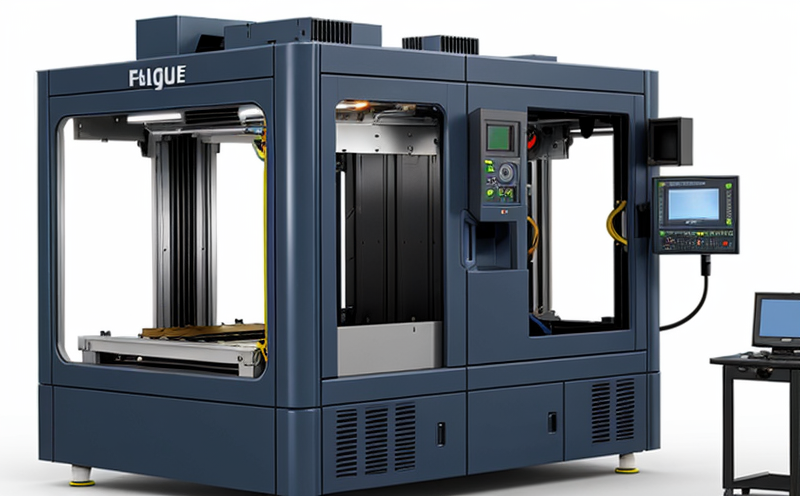ISO 12108 Fatigue Crack Growth Rate Testing
The ISO 12108 standard provides a comprehensive framework for fatigue crack growth rate testing of metallic components. This service is crucial for ensuring the reliability and durability of parts used in additive manufacturing (AM) and 3D printing processes, particularly those exposed to cyclic loading conditions.
Fatigue crack growth rate testing is essential because it helps identify the critical stage at which a crack begins to grow under repeated stress cycles. This information is vital for predicting the service life of components and ensuring they can withstand operational stresses without failure. The test is especially important in sectors like aerospace, automotive, and medical devices where component integrity directly impacts safety and performance.
The process involves subjecting specimens printed using AM techniques to cyclic loading until a fatigue crack appears. Once initiated, the crack growth rate is monitored under controlled conditions. This testing method allows for the evaluation of different materials and manufacturing parameters to optimize design and production processes. The results provide valuable insights into the fatigue behavior of parts produced through 3D printing, ensuring they meet or exceed industry standards.
For quality managers and compliance officers, this service ensures that additive manufactured components comply with relevant international standards such as ISO 12108-1 to -5. It helps in maintaining product integrity by identifying potential weaknesses early in the development process. For R&D engineers, it offers a robust methodology for optimizing design parameters like layer thickness, infill patterns, and build orientation.
ISO 12108 testing is particularly beneficial when evaluating parts that are subjected to cyclic loading conditions such as fasteners, gears, or structural components in aerospace applications. The test results can also inform the selection of appropriate materials for additive manufacturing processes by identifying those with superior fatigue properties.
The process involves several key steps: specimen preparation, cyclic loading application, crack monitoring using non-destructive testing (NDT) methods like ultrasonic testing or visual inspection, and data analysis to determine the fatigue crack growth rate. The results provide critical insights into the durability of parts produced through 3D printing.
By adhering to ISO 12108 standards, manufacturers can ensure that their additive manufactured components are reliable and safe for use in demanding applications. This service supports continuous improvement in quality assurance practices and contributes to safer design processes.
| Stage | Action |
|---|---|
| Specimen Preparation | Material selection, part geometry design |
| Cyclic Loading Application | Controlled stress cycles applied to the specimen |
| Crack Monitoring | Non-destructive testing methods employed |
| Data Analysis | Fatigue crack growth rate determined |
| ISO Standards | Description |
|---|---|
| ISO 12108-1 | General requirements for fatigue testing of metallic components |
| ISO 12108-3 | Guidance on cyclic loading and crack monitoring methods |
| ISO 12108-5 | Specific recommendations for additive manufactured parts |
Applied Standards
The ISO 12108 family of standards plays a pivotal role in the fatigue crack growth rate testing of metallic components produced through additive manufacturing and 3D printing. These standards provide the necessary framework for conducting these tests accurately and reliably, ensuring that the results are consistent with international benchmarks.
| Standard | Description |
|---|---|
| ISO 12108-1 | General requirements for fatigue testing of metallic components |
| ISO 12108-3 | Guidance on cyclic loading and crack monitoring methods |
| ISO 12108-5 | Specific recommendations for additive manufactured parts |
The standards outline the procedures for specimen preparation, cyclic loading application, crack monitoring using non-destructive testing (NDT) methods like ultrasonic testing or visual inspection, and data analysis to determine the fatigue crack growth rate. Adherence to these international guidelines ensures that the results are comparable across different laboratories and industries.
ISO 12108-5 specifically addresses the unique challenges associated with additive manufactured parts, providing recommendations tailored to their geometry, material properties, and manufacturing processes. This standard is crucial for ensuring accurate fatigue testing in this rapidly evolving sector.
Customer Impact and Satisfaction
- Ensures compliance with international standards such as ISO 12108-5
- Provides critical data for optimizing design parameters in additive manufacturing processes
- Reduces the risk of component failure due to fatigue crack growth
- Promotes safer and more reliable components for high-stress applications
- Supports continuous improvement in quality assurance practices
- Aids in maintaining product integrity by identifying potential weaknesses early in the development process
By offering ISO 12108 fatigue crack growth rate testing, we contribute to our customers' success by providing them with reliable test results that enhance their confidence in the quality and safety of their products. This service supports a competitive edge by ensuring that additive manufactured components meet or exceed industry standards.
Competitive Advantage and Market Impact
Fatigue crack growth rate testing, specifically using ISO 12108 standards, provides a significant competitive advantage in the additive manufacturing sector. It allows manufacturers to ensure that their products meet or exceed international quality and safety standards, thereby building trust with customers and stakeholders.
By adhering to these rigorous testing protocols, companies can demonstrate their commitment to product reliability and durability. This is particularly important for sectors like aerospace, automotive, and medical devices where component integrity directly impacts safety and performance.
The test results provide valuable insights into the fatigue behavior of parts produced through 3D printing, enabling manufacturers to optimize design parameters such as layer thickness, infill patterns, and build orientation. This optimization leads to improved product quality and enhanced customer satisfaction.
Furthermore, by ensuring compliance with ISO standards, companies can differentiate themselves in a crowded market. The ability to provide reliable test results that meet or exceed international benchmarks sets them apart from competitors who may not have the same level of expertise or resources.





